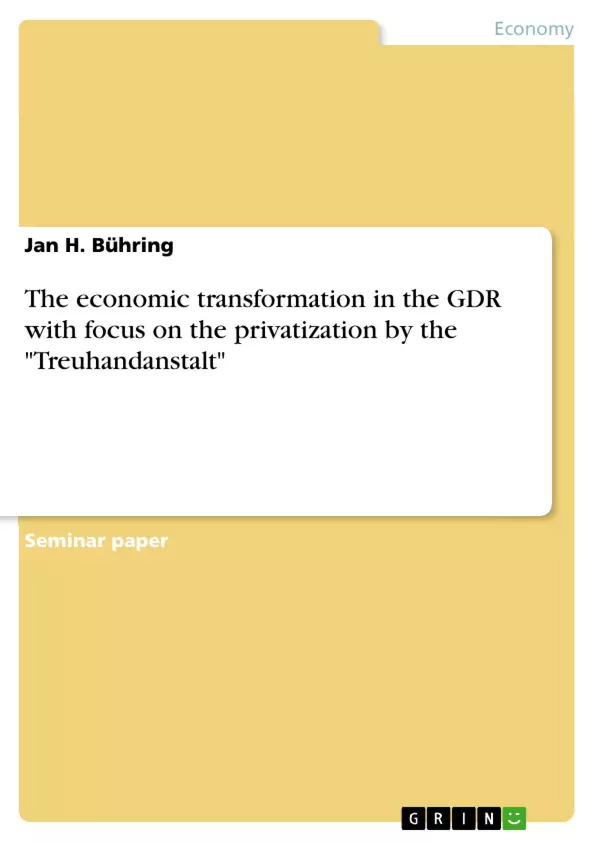For an appropriate comprehension and consequently treatise of the German ‘Treuhandanstalt’ (THA) or shortened ‘Treuhand’, trust agency as literal translation and privatization agency as analogous translation, it is absolutely necessary to keep in mind the history and context.
“It would be hard to devise a better controlled experiment for comparing different economic systems than the experience provided by East Germany and West Germany: two nations that formerly were one, occupied by people of the same background, the same culture, and the same genetic inheritance, torn apart by the accident of war. On one side of the Berlin Wall is a relatively free economic system; on the other side, a collectivist society” (Milton Friedman 1986, cited in Collier/Siebert 1991: 196).
Milton Friedman was assuredly surprised when his ideal field for experimentation of comparing ran in another direction three years later. As commonly known, the mentioned Berlin Wall fell on 9 November 1989 and became the starting point of a never seen before transformation of the German Democratic Republic (GDR) according to his geographical and geostrategic position also known as East Germany. Nevertheless the statement of the recipient of the Nobel Memorial Prize in Economic Sciences and in general one of the most famous economists of the 20th century remains unaffected. The origin of the so-called ‘German reunification’ or ‘the turning point’ is unique; the still special circumstances liberated by the fall of the Berlin Wall, which only formed part of a series of the demolishing Iron Curtain, led to incomparable possibilities regarding transformations in many countries in Central and Eastern Europe (CEE). The formal political accession, occurred on the 3rd October 1990, is a quite famous date and its anniversary is nowadays the national day, the ‘day of German unity’. The Federal Republic of Germany (FRG), previously known as West Germany, from this day forth consisted of sixteen federal states, eleven old and five new ones. But another, earlier aspect of the reunification is not so well known: the bilateral state treaty about the creation of a monetary, economic and social union (MESU) of 18 May 1990, that came into effect on 1 July 1990. This was the comprehensive economic integration of the command economy GDR in the capitalistic, more precisely social market economy, FRG.
Inhaltsverzeichnis (Table of Contents)
- Introduction
- Initial Situation - The inherited Socialist Economy
- General Theory of Transformation and Privatization applied to the GDR
- Macroeconomic Stabilization and Control
- Price and Market Reform
- The Role of the State
- Enterprise Reform
- Privatization in the GDR - The Treuhandanstalt
- Success and Conclusion
- Sources
- Literature Sources
- Online Sources
Zielsetzung und Themenschwerpunkte (Objectives and Key Themes)
This seminar paper aims to analyze the economic transformation of the former German Democratic Republic (GDR) following reunification, focusing specifically on the privatization process orchestrated by the Treuhandanstalt. It will delve into the historical context and explore the theoretical framework of economic transformation and privatization, particularly in the context of a socialist economy. The paper will also examine the practical implementation of these theoretical principles within the GDR and assess the success of the privatization program.
- The historical and political context surrounding the reunification of Germany and its impact on economic transformation.
- The theoretical underpinnings of economic transformation and privatization, particularly as applied to a socialist economy.
- The role and function of the Treuhandanstalt in the privatization process of the GDR.
- An analysis of the successes and challenges of privatization in the GDR.
- The enduring legacy of the German reunification and its economic consequences.
Zusammenfassung der Kapitel (Chapter Summaries)
- Introduction: This chapter sets the stage for the paper by outlining the historical background of the German reunification, emphasizing the unique context of the GDR's transformation compared to other former socialist countries in Central and Eastern Europe. The chapter also highlights the significance of privatization, particularly through the Treuhandanstalt, as a key aspect of this economic transition.
- Initial Situation - The inherited Socialist Economy: This chapter provides a detailed description of the economic system inherited by the GDR, examining its strengths and weaknesses, as well as the challenges posed by the transition to a market economy.
- General Theory of Transformation and Privatization applied to the GDR: This chapter explores the theoretical frameworks of macroeconomic stabilization, price and market reform, the role of the state, and enterprise reform in the context of a socialist economy transitioning to a market economy. It delves into the theoretical implications of these concepts for the GDR's specific situation.
- Privatization in the GDR - The Treuhandanstalt: This chapter focuses on the specific case of the Treuhandanstalt, analyzing its role as the main agency responsible for privatizing GDR enterprises. It explores the practical challenges and successes of this vast undertaking, examining the policies and strategies employed by the Treuhandanstalt.
Schlüsselwörter (Keywords)
The key terms and concepts central to this paper include German reunification, economic transformation, socialist economy, privatization, Treuhandanstalt, market economy, enterprise reform, macroeconomic stabilization, and price and market reform. These terms encapsulate the focus on the transition of the GDR from a socialist system to a market-oriented economy, highlighting the role of privatization and the Treuhandanstalt in facilitating this transition.
- Quote paper
- Jan H. Bühring (Author), 2013, The economic transformation in the GDR with focus on the privatization by the "Treuhandanstalt", Munich, GRIN Verlag, https://www.grin.com/document/277659



